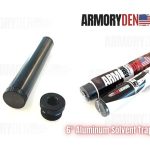D Cell Solvent Trap vs. the C Cell Solvent Trap
Solvent traps are attached to the end of the firearm that catches the fluids from cleaning. Regular cleaning can maintain the integrity of your firearm and avoid troubles.
The Importance of Firearm Cleaning
Moisture are not friendly to firearms. Corrosion happens when firearms are stored right after use. There is corrosive ammunition that can react to the firearm metal and cause rusting.
Another factor that can damage a firearm through time is the small moving parts inside that grind against each other, so the more you use, the more they wear out faster.
These things that cause firearm damage can be prevented and delayed with regular maintenance and using the right cleaning tools.
What you Need to Know About Solvent Trap Cups
If you go on regular firearm maintenance, you are familiar that the cleaning session can give an awful smell, aside from the possible mess if you do not use a solvent trap.
D Cell Solvent Trap vs. the C Cell Solvent Trap
For starters, C cell solvent traps have smaller dimensions than the D cell solvent traps.
Solvent Trap Tubes
On the other hand, the C cell has a 1.23″ outside diameter and an inside diameter of 1.03.”
Solvent trap tubes come in various sizes based on cell sizes. Make sure to choose the one that fits your firearm.
End Caps
D cell solvent traps have thread protector to include 1/2 X 28 and 5/8 X 24, and the C cell has a thread protector size of 1/2 X 28.
Take note that a C cell accessory is only compatible with a C cell solvent trap kit. Make sure to pick one that is compatible with your firearm.
Advantages Of Having A Solvent Trap
The good thing about solvent trap kits is that they are very affordable that goes a long way. You can recycle the solution trapped in the cup and lengthen the lifespan of your firearm.
How to use your C Cell or D Cell Solvent Trap
When you have your C cell or D cell solvent trap for the first time, inspect all the necessary parts such as the round tube, sealed end cap, storage cups, and end cups.
2. Item assembly
To start putting the solvent trap together, lock one side of the round tube that fits the end of the firearm and then slide the K cups into the tube and lock the other end using the sealed end cup.
3. Attach the solvent trap to the firearm
Simply attach the solvent trap to the end of the firearm and secure it with the correct thread protector.
4. Start cleaning
Once your C cell or D cell solvent trap is secured on the firearm, you are now ready to clean. Pour the solvent in, and brush and clean every spot you can reach. No matter how much you push, everything will go to the solvent trap.
What's the Best Material for Solvent Traps?
How To Choose a Solvent Trap?
As you shop around, there may be shady websites that sell low-grade solvent traps, or they may even be illegal that will get you in trouble with the law. Armory Den sticks with selling only legal solvent traps without the need for a Form 1 because it is intended for cleaning only.






